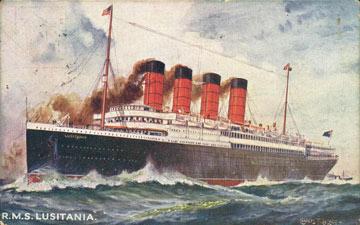Maritime Tale - Lusitania Survivor

A contemporary postcard of Lusitania
At my local church – St James’s in West Derby – you can see a unique glass memorial with an image of Lusitania prominently included to symbolise Liverpool’s suffering in the Great War.
The strange behaviour of a passenger was followed by one of the great maritime disasters.
Robert Timmis was strolling along the deck with his work colleague Ralph Moodie when they saw a man strap on his lifebelt and climb into a lifeboat.
No-one could persuade the passenger – 43-year-old Michael Pappadopoulo, from Greece - to get out.
Did he have a premonition? He must have been overcome with some overwhelming fear to take such drastic action.
Pappadopoulo spent an uncomfortable night in the lifeboat and presumably was relieved when the day dawned and everything was running smoothly.
It was 7 May 1915 and a glorious spring day as the Lusitania headed for Liverpool, the Irish coast on her port side
Timmis was a British cotton trader who was based in Gainesville, Texas. He and Moodie played medicine ball before going to lunch.
While they were eating, a U-boat submarine had stalked the Lusitania and fired a torpedo. Timmis later described the impact as a “penetrating thrust” – the ship was already listing when they had left the dining room.
Chaotic scenes followed as people scrambled for the boats as the great ship settled deeper and deeper into the water. Timmis was a big, solidly-built man and people sought reassurance from him.
Steerage passengers crowded around, many of them Russians who could not speak English.
Just 18 minutes after being struck by the torpedo, Lusitania took her final plunge. Both Timmis and Moodie were dragged down with her.
Timmis, a strong swimmer, remained remarkably calm and counted the 32 strokes it took to get back to the surface - he reckoned he had been sucked down 60 ft. He was later rescued by the Lusitania’s carpenter, Neil Robertson of Bootle. Moodie was never seen again.
At Liverpool's Maritime Museum there is an inscribed photograph given by Timmis to his rescuer.
It reads: “To Neil Robertson, carpenter, Lusitania who took me into a damaged collapsible Lusitania boat about two hours after the ship had been torpedoed May 7 1915. I being in the water without a lifebelt. He acted as a good seaman and a brave man.”
Michael Pappadopoulo, whose forebodings had proved so correct, was also among the 1,200 people who died.
His wife Angela, wearing a sweater and trousers given by a crew member, swam a long way towards the distant shore before being rescued.
